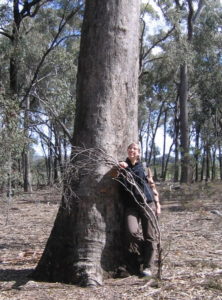
Christina Czembor
University of Melbourne
Received the Australian Flora Foundation Young Scientist Award for her talk at ESA 2008, the Ecological Society of Australia Conference on 1 – 5 December 2008 at the University of Sydney.
Christina Czembor and Peter A. Vesk – School of Botany, The University of Melbourne, Victoria, Australia
Victorian Box-Ironbark forests have higher densities of small stems and a paucity of old-growth characteristics, such as large, hollow-bearing trees, in relation to pre-European forests. Since old-growth vegetation provides high quality habitat for many vertebrate species, managers are interested in restoring these characteristics. Managers believe that a new management technique, “ecological thinning”, will decrease competition and assist in the restoration of Box-Ironbark forests because retained stems should grow faster than stems in non-thinned stands. However, thinning trial results could be inconclusive in the short term due to the slow growth of eucalypts.
The primary aim of our study is to model the potential effects of ecological thinning. Our models predict how ecological thinning, current management practices, and natural disturbances are thought to change current stands into higher quality habitat. Expert knowledge was used to construct models due to the dearth of relevant stand dynamics data. We quantified between and within-expert variation to see how uncertainty affected model predictions.
We found that the majority of uncertainty in model predictions was due to between-expert variation. We also found that model predictions for ecological thinning were far more uncertain than predictions for current management or natural disturbances. As a result, our current models predict that ecological thinning could be detrimental to stand development. Thus, we cannot recommend thinning as a strategy to increase old-growth characteristics in Box-Ironbark forests. However, as monitoring data are collected, we can update our models and reduce the uncertainty in predictions of the long-term effects of ecological thinning on vegetation development
